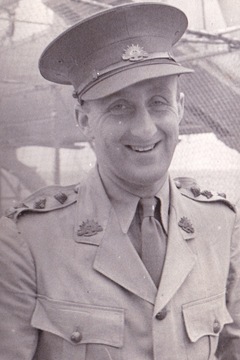CONNELL, John Fletcher
| Service Number: | VX13901 |
|---|---|
| Enlisted: | 1 March 1940 |
| Last Rank: | Major |
| Last Unit: | Not yet discovered |
| Born: | Lockhart, New South Wales, Australia, 25 May 1913 |
| Home Town: | Goolwa, Alexandrina, South Australia |
| Schooling: | Melbourne Grammar School, Melbourne, Victoria, Australia |
| Occupation: | Doctor (Medical Practitioner) |
| Died: | Heart attack, Goolwa, South Australia, Australia, 15 July 1989, aged 76 years |
| Cemetery: |
Springvale Botanical Cemetery, Melbourne Plot: Diosma Garden 1, Bed 62 – Position 103. |
| Memorials: |
World War 2 Service
| 1 Mar 1940: | Enlisted Australian Military Forces (WW2) , Major, VX13901 | |
|---|---|---|
| 7 May 1946: | Discharged Australian Military Forces (WW2) , Major, VX13901 |
Help us honour John Fletcher Connell's service by contributing information, stories, and images so that they can be preserved for future generations.
Add my storyBiography contributed by Alan O'Connor
John Fletcher Connell was born at Lockhart, NSW on 25 My 1913. He grew up there with his brothers Bill and Barry until the family moved to Mont Albert, Melbourne. After schooling at Melbourne Grammar, John studied Medicine at the University of Melbourne and graduated as a doctor in 1938. At university he gained two full blues in swimming and won the open Victorian championship in the 400 metres. He was also an excellent rifle shot.
He enlisted on 5 April 1940 and travelled on the Stratheden from Melbourne. On board he soon met his future wife Nurse Veronica Coghlan. He was initially posted to the Connaught Military Hospital Aldershot in the UK.
He and Von were involved in some amazing incidents during their postings. On 30 September 1940 John was motoring along a lane in Windsor Great Park and his attention was drawn to an aerial dogfight between an RAF plane and a Messerschmitt. The RAF pilot who happened to be a New Zealander, caused the Messerschmitt to make a forced landing in a field nearby. John ran up and took the German pilot prisoner. The German plane was carted to the exterior wall of Windsor Castle and was put on display to the public to raise funds for the Borough’s Spitfire Fund. A painting of the event by Paul Nash is now held at the Tate Gallery, London.
From John’s diary “We were walking back to the hospital when we heard a bomb coming down. All I could do was to push Von into the gutter and sit on her. The bomb landed around the corner. Von said ‘I don’t know what you are doing but my skirt is getting very dirty in this gutter.’ Typically there was no sign of any fear from Von.
John left on the Llandovery Castle with Australian patients and arrived in the Middle East (Suez) on 21 May 1941. He was posted to Palestine and soon became RMO of the 2/ist Australian Infantry Battalion for the Syria campaign. “ He was a lanky, humorous, sociable Victorian who quickly got to know the battalion, training stretcher-bearers and gaining the confidence of all ranks – this was to be amply justified in the days to come” from “First at War”.
John was shipped to PNG on 12 September 1942. He had enormous respect for the local ‘fuzzy wuzzy angels’ – they worked as a team of 8 stretcher bearers for every soldier evacuated. Against the Japanese in the Eora Creek battle of the Owen Stanley campaign, John was wounded while operating under fire for 72 hours. He was awarded the Military Cross for his actions. His CO recorded that ‘he was revered and respected for his courage and gentle care’.
John was later acknowledged as a pioneer in the use of Atrebin as a malaria suppressant drug. All staff had to take 2 tablets a day with no reports of malaria until they arrived back at Port Moresby.
John’s letters to his mother were hilarious – along the lines of Oh What a Lovely War to ease any worries. ‘Yesterday I was flat out – started at 11 and finished at 10 pm with 25 surgical cases incl amputations, fractures and blokes with bowels hanging out. All chaps alive and going well. I am working about 200 yards from the Japs. One lad I was operating on was shot in the opposite leg as I was sewing up the other. 3 cases are arriving by stretcher so the fun starts – all is well – all I want is letters, chocolates and cigarettes.’ From a diary entry by John.
John was finally posted to a field hospital with the rank of Major. On completion of his war service, John developed an extensive Medical practice at Kyneton in Victoria. He married Von in 1947 and she joined him in the practice. They had two children – Sue born in 1948 and John in 1950. John was the president of the local Lions Club and Golf Club. He was the swim team doctor at the 1956 Olympics.
He was the driving force behind the community service organization Windarring for the Intellectually disabled. After ‘retirement’ to Goolwa in South Australia, John was enticed to join the local medical practice. He was often cautioned by Police as he sped into Adelaide in his Silver Shadow for some major operation. He died on the golf course from a heart attack on 15 July 1989.
A copy of a photobook of the WW11 life of John and Von compiled by Alan O'Connor, the husband of Joan the niece of John and Von, has been accepted by the Australian War Memorial.

















